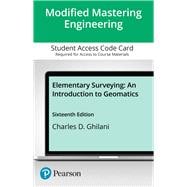Elementary Surveying: An Introduction to Geomatics presents basic concepts and practical material in each of the areas fundamental to modern surveying (geomatics) practice. While introductory, its depth and breadth also make it ideal for self-study and preparation for licensing examinations.
The 16th Edition includes more than 400 figures and illustrations to help clarify discussions and rewritten worked example problems to illustrate computational procedures. It is updated throughout to provide a state-of-the-art presentation of surveying equipment and procedures, including new discussions of GNSS Precise Point Positioning; small unmanned aerial systems; metadata; new gravimetric- and geometric-based datums for the United States in 2022; and the computational changes to the state plane coordinate systems in 2022.
Personalize learning with Mastering Engineering with Pearson eText
This flexible digital platform combines unrivaled content, online assessments, and customizable features to personalize learning and improve results. Mastering® includes new Coaching Activities and updated versions of Stats, WolfPack, and Matrix to help you further your understanding of surveying computations.
Pearson eText is an easy-to-use digital textbook available within Mastering that lets you read, highlight, take notes, and review key vocabulary all in one place.
NOTE: Before purchasing, check with your instructor to confirm the correct ISBN. Several versions of the Mastering platform exist for each title, and registrations are not transferable. To register for and use Mastering, you may also need a Course ID, which your instructor will provide.
Used books, rentals, and purchases made outside of Pearson
If purchasing or renting from companies other than Pearson, the access codes for the Mastering platform may not be included, may be incorrect, or may be previously redeemed. Check with the seller before completing your purchase.











